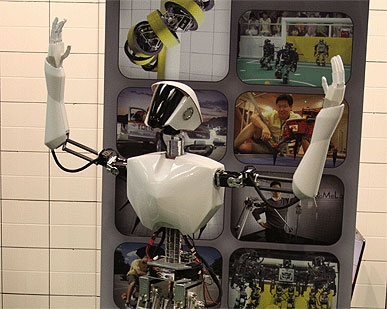According to the NRL, a humanoid-type robot was chosen because it was considered best suited to operate within the confines of an environment that was deigned for human mobility. It adds that the robot could be used for potential warfighting applications within the US Navy and Marine Corps.
Dubbed SAFFiR (Shipboard Autonomous Firefighting Robot), the system is being designed to move autonomously throughout a ship and interact with people, as well as fight fires.

The robot is reportedly being designed with enhanced multi-modal sensor technology for advanced navigation and a sensor suite that includes a camera, gas sensor, and stereo IR camera to enable it to see through smoke.
The NRL says the robot’s upper body will be capable of manipulating fire suppressors and throwing propelled extinguishing agent technology (PEAT) grenades. Its battery power source will hold enough energy for 30 minutes of firefighting and, like a human sailor, it will be capable of walking in all directions, balancing in sea conditions, and traversing obstacles.
Another key element of the SAFFiR development is to allow damage-control personnel and the robot to work cohesively as a team.
Algorithms are being developed to allow autonomous mobility and decision making by the robot as a team member. To enable natural interaction with a human team leader, the robot will have multimodal interfaces that will enable the robot to track the focus of attention of the human team leader, as well as to allow the robot to understand and respond to gestures, such as pointing and hand signals. Where appropriate, natural language may also be incorporated, as well as other modes of communication and supervision.
Researchers from Virginia Tech and the University of Pennsylvania are also working with the NRL on the project.
They plan to test the firefighting robot in a realistic firefighting environment on board the ex-USS Shadwell in late September 2013.





Poll: Should the UK’s railways be renationalised?
I'm reminded of the old adage about stupidity is doing the same thing time and time again, expecting different results. The current model simply...